If you are of a certain age (ahem), you remember the old days when you heard about anything and everything—such as news, celebrity gossip, and product launches—through the newspaper, billboards, radio, or television.
Not anymore! Social media has changed our lives. Therefore, it’s safe to say that it’s changed the way we do business.
Social media has changed the way we do business!
And, that’s okay except that social media is constantly changing. If you don’t stay on top of the details, you can lose a lot of time trying to figure it out. That’s why I’ve compiled this list of common social media questions.
Whether you’ve been using social media to market your business or you’re new to “the socials,” these answers can help. There’s always something to learn about how to use social media marketing strategically, without creating a massive time-suck in the process!
1) Should I use social media for marketing?
The official answer? It depends.
Not every business or brand is meant for social media. But, the answer is most likely a resounding “YES!” You can probably benefit from being on at least one platform.
Social media is undoubtedly here to stay. Current social media statistics show that there are almost 3.8 billion social media users worldwide, which is 48% of the population!
Plus, consumers spent an average of 2.5 hours per day on social media in 2020. That’s a lot of time!
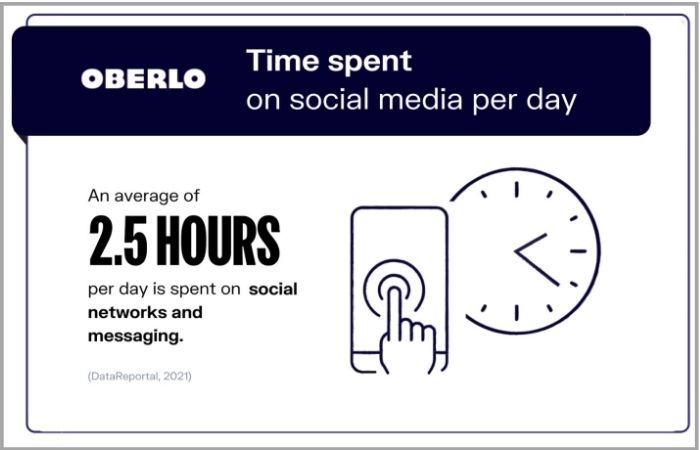
What’s even more interesting is that social media isn’t just for socializing anymore. According to GlobalWebIndex, 54% of social browsers utilize social media to research products.
In other words, if you’re not on social media, some of your prospects may not discover you. So, it’s increasingly important for your business to have a social media presence.
Your customers are spending time on social media. To reach them where they go to socialize, read about the news, research products, and chill, social media marketing is an option.
2) What social media platform should I use to market my business?
As much as you want to be visible on social media, it is not time well spent to try and be on EVERY platform. Why? Because the majority of your customers are not on every platform.
YouTube and Facebook dominate in terms of where the most people hang out on social media in the United States.
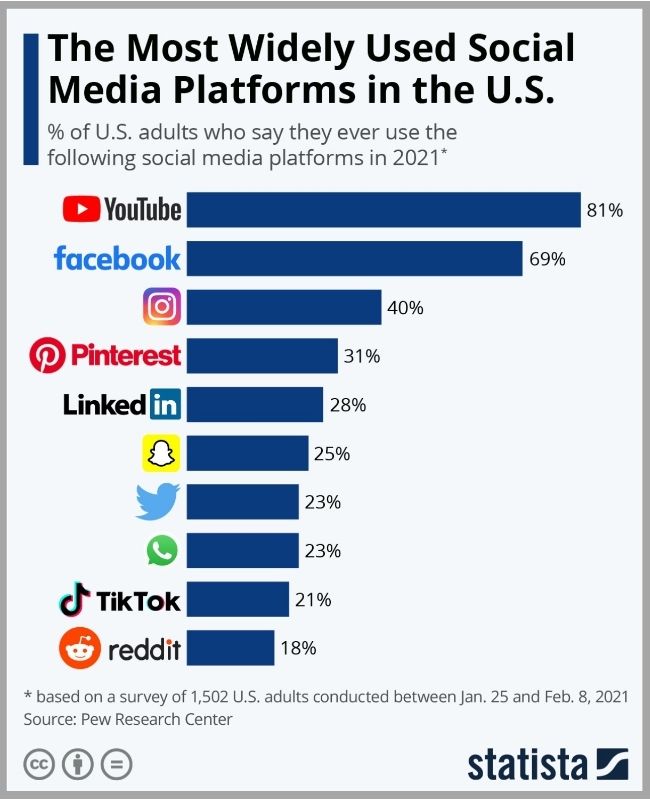
BUT…don’t market based on popularity alone. Invest your time, energy, and money in creating content for the social platform where your ideal customer spends their time. Also factor in your personality and preferences.
So, how do you know which social media network your business should use?
You could collect the demographics of your last 10 buyers.
- How old are they?
- Are they male or female?
- Are they consumers or business owners?
- Did they go to college?
Determine which network you should start with by comparing your buyers’ demographics with each platform’s audience.
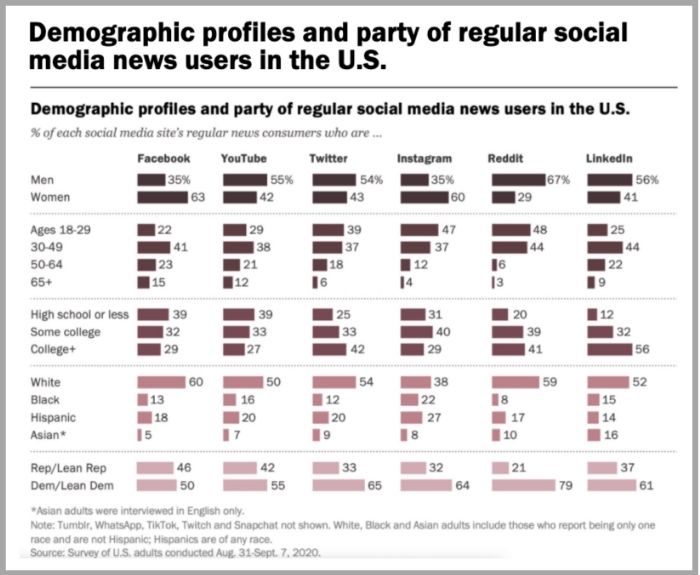
Pay close attention to each social network’s content requirements too. For example, if you don’t have the resources to create videos, then YouTube isn’t going to work for you.
3) What should I post on social media?
Great question! Of course, what you should post depends on your business.
Before creating any content, start with creating a social media strategy. Your business goals and target audience guide your content. It’s all about what goals drive your social media marketing and who you’re trying to attract. So, you need to get crystal clear on those things first.
If you are using social media for fun, by all means, post away, willy-nilly, to your heart’s content!
But, if your goal is to build your brand, get in front of more people, and ultimately make more sales, then you need to have a strategy.

At first, creating effective social media content feels difficult. Once you create a social media strategy, content creation gets easier.
In general, there are certain types of content that work better on social media. Create content that does one (or more) of these three things:
Educates or informs your audience
- What can you teach your audience?
- What is their biggest frustration?
- How can you solve their biggest problems and frustrations?
Inspires your audience
- What resonates with your audience?
- Which type of content will create emotion for your audience?
Entertains your audience
- How can you make your audience laugh?
- What will capture their attention?
In terms of format, video rules! If you cannot record videos, then try images since they get more mileage than text alone.
The key to remember is to post content for your audience, not your business.
4) Is it okay to download photos from Google and use them on social media?
Absolutely not!
Downloading, copying, and pasting photos directly from the internet is a big no. Assume that copyright laws protect images on the internet. Using someone else’s image without their permission means that you’re liable and could get sued.
The only exceptions in the law are images that allow public use, like fair use and free-to-use images on Google.
Fair use of a copyrighted work, including such use by reproduction in copies or phono records or by any other means specified by that section, for purposes such as criticism, comment, news reporting, teaching (including multiple copies for classroom use), scholarship, or research, is not an infringement of copyright. Source
There’s no reason you can’t purchase images, subscribe to a stock photo service, or use an image creation tool (like Canva) where they have taken care of the legal mumbo-jumbo for you.
Also, check out free image sites like Pixabay and Unsplash for your visual content.

5) How do I measure my ROI from social media?
Measuring your return on investment from social media requires setting goals and tracking them. According to Hootsuite, the formula is:
Value / investment (people hours, ad budget, etc.) X 100 = social media ROI (as a percentage)
ROI is a pain point for many business owners. They expect to post on social media and see a direct sale. It’s not that simple!
Figuring out your ROI may be difficult. The only way to know if your efforts are paying off is to set an expectation and then measure whether you’ve met that expectation or not. You’ve got to set goals and related performance metrics and track them.
Here are a few examples of metrics you may track to determine social media ROI:
✦ Email list signups
✦ Contact form inquiries
✦ Website visits
✦ Trials
✦ Purchases
✦ Downloads
The calculation can get complicated with the number of steps in your funnel. To keep it simple, take this example:
You spent $100 on Facebook ads (or paying a social media manager), and sell 10 $25 products, equaling $250. Subtract your expenses ($100) and you’ve made $150. Divide your profit ($150) by your investment ($100) and the answer is 1.5. Multiply by 100 and you have your ROI = 150%.
Some people believe that ROI is a financial/monetary measurement only. However, remember that social media’s value may extend past dollars and cents. If you can’t attribute social media to revenue, that doesn’t mean it isn’t an effective, valuable investment.
The important takeaway here is to set goals with related metrics to measure whether you’re meeting your objectives or not.

6) Do I need to hire a social media manager?
You have a LOT on your to-do list, and social media is likely at the bottom of it.
Let’s say you know a lot about social media marketing and you’re comfortable (and consistent!) managing it yourself. That doesn’t change the fact that social media is extremely time-consuming. Just because you can doesn’t mean you should!
Just because you can doesn't mean you should manage your social media! Reserve your time for the higher level tasks in your business. #productivityClick To TweetSo, the answer is no, you don’t have to hire a social media manager. But, they are the expert and have the time. Your job is running the business and bringing in the bucks.

Let me ask you this, how many hours do you spend managing your social media?
At six hours a week (the average most business owners spend), that’s 24 hours a month. If your time is worth at least $50 an hour, that’s $1200 a month. I’m certain you can outsource this task to an expert for less rather than waste your precious time.
7) How often do I need to post?
It depends on which social network we are talking about. Also, your concern should not be the number of posts you are creating each day. Focus on the quality.
However, if you like things black and white like I do, here are the recommendations from expert LouiseM.com:
Facebook: 1 x per day with a maximum of 2
Twitter: 15 x per day with a maximum of 30 spread throughout the day
Instagram: 1-2 x per day spread throughout the day
LinkedIn: 1 x per day
Pinterest: 11 x a day with a maximum of 30
YouTube: 1 x per week
8) What time should I post?
Posting times differ across platform, your target audience, your industry, and your topic. There’s no one answer!
Some may argue that it doesn’t matter what you post because the algorithms control the feed. However, it is still worth looking at the insights to learn what the best times are to post on each network.
Sprout Social did an in-depth discussion about the best times to post. Check out their article about it. Here are the highlights for general posting times.
Best times: Tuesday, Wednesday and Friday 9 a.m.–1 p.m.
Best days: Tuesday, Wednesday, Friday
Worst day: Saturday
Best times: Wednesday 9 a.m.– 3 p.m., Tuesday through Thursday 9–11 a.m.
Best day: Wednesday
Worst day: Saturday
Best times: Tuesday 11 a.m.–2 p.m., Monday through Friday 11 a.m.
Best day: Tuesday
Worst day: Sunday
Best times: Tuesday through Thursday 9 a.m.–noon
Best days: Tuesday and Wednesday
Worst day: Sunday
Always analyze how your posts are performing and try different times. Also, check to see if your social media management tool offers any information about custom optimum times based on your past performance.
9) How do I increase my followers?
This is one of the most asked social media questions! The short answer?
Show up consistently.
Be present regularly on social media to answer questions, share related content in your niche, and engage with your prospective customers. It’s very much like networking but online.

Here are a few concrete ideas to increase your follower count:
✦ Follow other brands, influencers, and users in your niche
✦ Share other brands and users content
✦ Cross-post your content on multiple platforms
✦ Invite followers on one platform to follow you on another
✦ Get involved in social communities like Facebook groups and Twitter chats
✦ Invest in paid ads
PRO TIP: Do not buy fake followers! It’s not worth it. In fact, fake followers can harm your account and mess with your stats. Don’t do it!
10) Do I need to pay for social media ads?
While I wish the answer is no, if you want to reach your target audience, the answer is yes.
The reason is, particularly on Facebook, organic reach for brands is almost down below 5%. Even in the case of local businesses (which I find to have a much higher reach), the fact remains that every post does not reach ALL of the followers. To do this, you must spend money to boost the post.
Why? It would be fun to blame the Mark Zuckerberg’s of the world! But, the truth is that there is too much competition! Many marketers are clamoring to get noticed on social media. The space is overcrowded.

In addition to spending a little money to get your message out there, plan on targeting your intended audience and building an online customer journey. This plan will help with that ROI we just discussed.
And, having a proven path for sales—such as sending people to a high converting web page or getting people on a phone call—will yield better results.
All social media networks offer advertising, but this doesn’t mean you should use all of them. And, my advice is to start small—in both the target audience and ad spend. It’s all about testing, so be prepared to try out a LOT of different things. (P.S. hire an expert!)
11) Do I need a social media content calendar?
To see success on social media, use a calendar!
Using a social media calendar has changed the way I manage my clients’ social media as well as Smart Bird clients in the past. Combined with a good tool, you can save hours and hours of work.
Seriously!
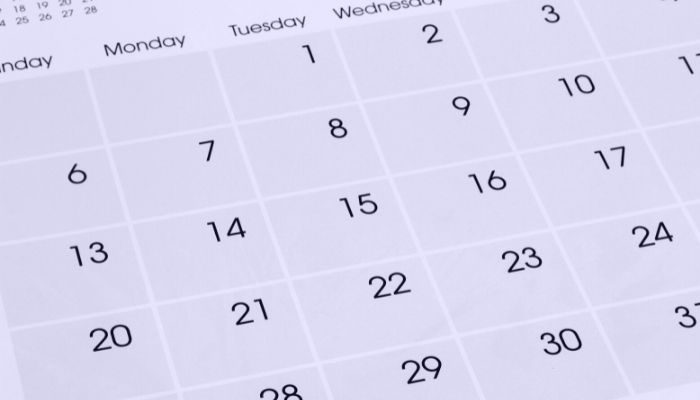
A good calendar should:
✦ Help carry out your content strategy
✦ Organize campaigns, special promotions, holidays and other occasions
✦ Make it easier to post consistently and in a timely manner
✦ Help you track your best performing content so that you can create more
And, perhaps the best of all…SAVE TIME!!!
Use my super simple social media plan to get started.
12) Can I use the same posts across multiple platforms?
Sharing the same posts on different social media networks is tempting. It saves time, it keeps your accounts moving, and most of all, it’s easy!
However, I would not recommend it unless you’re strategic about it. The visual dimensions make a difference. Even your scheduling tool can affect the outcome.
Have you ever seen an Instagram post on Twitter? Sure, you see the image, but sometimes it includes this weird URL with no legible caption.
Also, the same text doesn’t work across all platforms. For instance, tweets are short, so your text from Instagram or Facebook will likely get cut off. Not to mention, Instagram posts perform better with lots of hashtags whereas Facebook and LinkedIn do better with less hashtags.

Let’s not forget about image sizes! Instagram and Facebook images look great in a square shape. Twitter and LinkedIn are more about rectangles. Pinterest is all about the vertical image. If you post one image to all of these platforms, it could look terrible!
This isn’t the end of the world. However, it is unprofessional. It sends the message to your followers that you are lazy, not committed to your social media presence, and not present on the platforms since you’re clearly unaware of the nonsense you’re posting. 😉
But, you can take advantage of repurposing your social media content across certain platforms. For example, images measuring 1200×630 px look okay across Facebook, LinkedIn and Twitter.
It will really depend on the platforms and the visual dimensions you use. Test and make adjustments as needed.
13) What do I do if someone negatively comments?
By now, we all understand that social media is an environment that has its own rules. People can sling mean comments all day long without any repercussions since they are protected behind their screens.
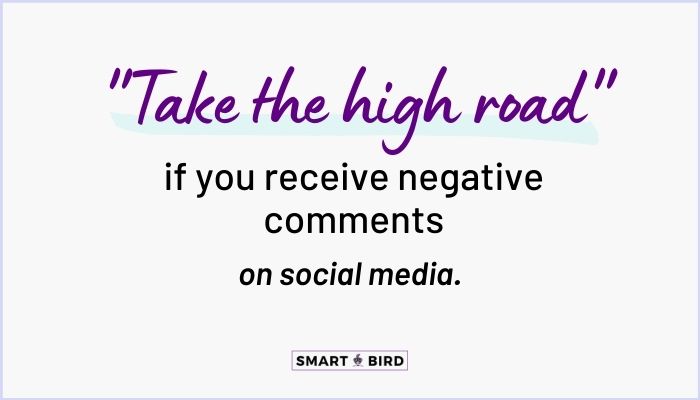
However, in business, it’s important to address any and all public comments. When addressing a negative comment on your social networks, you should:
✦ Respond quickly
✦ Apologize when it’s your fault
✦ Take the conversation offline as soon as possible (most people will not step up to the plate!)
✦ Do not get defensive
✦ Don’t feed the trolls!
Every case is different, but the rule of thumb is to “take the high road.”
14) Do I need a tool to manage my social media marketing?
Using a social media management tool will make your life easier. So my answer is yes, use a tool to manage your social media content marketing.
There are many tools to choose from. Look for tools that help you find great content, schedule your posts easily, and provide you with analytics so that you can create more of your most successful content.

We’ve used many different tools, including Buffer, Hootsuite, Eclincher, Social Report, and SocialOomph. It really comes down to what functionality you need, your personal preferences, and your budget.
Start with a free tool. When you are ready to pay for your social media tool, there are plenty of options. Most tools offer a free trial.
Pick one, try it out, and move on to another if it’s not working for you! Personally, I like to use a tool that helps to curate content, schedules in bulk, and offers queues for each social network. Recycling past posts is another nice feature because it saves time.
15) How do I engage with others on social media?
Engagement is just another word for talking to people online. If you want your social media efforts to be successful, you must engage with people! After all, that’s the advantage of social media…to build the know, like, and trust feelings with your fans.
“Without engagement, social media is just media. People don’t use social networks for a one-way experience. They’re seeking connections—with people and with brands.” – Buffer
Psychology proves that there are emotional reasons that influence people’s purchase decisions. So, it’s important to interact with your online community. This way, they get a good impression of your brand, personality, and style. And, they get a sense that you’re a real person, which can help with credibility and trust.
Imagine your Facebook page as a networking event. You roam around the room and chit-chat about this or that. You can be talking about personal or professional things.
The bottom line is engagement shows your buyers that you are a real face behind the computer. This is especially important for small business. How else could you compete with the big guys who have unlimited resources?
16) What should I name my accounts?
Are you a personal brand or the face of your business?
Think about how someone would search online for your products or services. Would they look up your name? Or, would they look up the name of your business, for example?
This is how to determine your social media handle or account name.

For example, a business coach or consultant should definitely use their own name on social media. But, a store or restaurant should reflect the name of the business.
It’s much, MUCH easier to interact with others online as yourself. People trust other people more than a logo or a faceless company name. So, if you can use your personal information as your account name, do it!
17) Is it okay to promote my business on social media?
Of course! We wouldn’t be answering social media questions if it wasn’t. 🙂
But, there is a right way and a wrong way.
One common pitfall of both personal brands and businesses is that they advertise on social media in the manner as you would on television or radio. The problem? This doesn’t work.
Social media is SOCIAL! This means showing up on your profiles and educating, inspiring, and entertaining your audience. Otherwise, you’ll annoy your followers.
Limit yourself to only 20% or 10% of your content being promotional in nature.
People are on social to interact and stay updated on friends, family, news, and gossip. You’ve got to fit in appropriately amongst the personal content and resist acting like an obnoxious salesperson.
I suggest you provide value 80% of the time and promote yourself the other 20%. That means for every one promotional post you must share four value-based posts.
18) Does social media help with SEO?
This is a sticky subject. Some experts say yes, some say no.
Either way, you can use SEO and social media strategies in tandem to help your content show up in search. So, in that way, the answer is yes.
Indirectly, SEO is achieved when you share your content such as blog posts, articles, and other website pages. The more visits your website has, the higher Google will rank your content. By using Google Analytics reporting, you can see how well each channel is sending traffic to your website, therefore boosting your SEO.
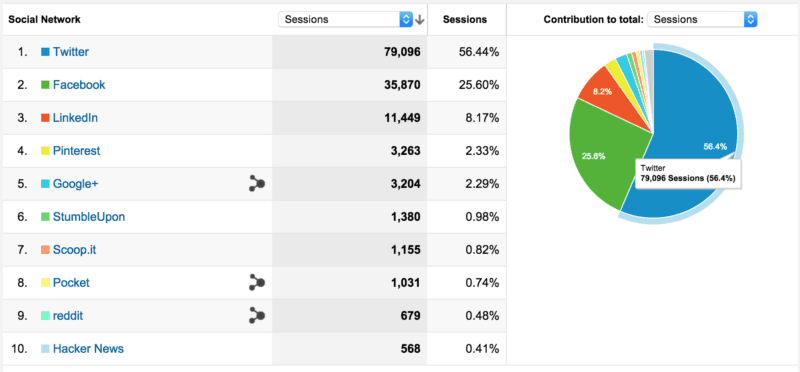
Did you notice that when you perform a search in Google, social media content shows up? It’s true!
Social media pages are like other website pages…meaning, your social media content is searchable.
Plus, some experts believe that the more followers you have and the more active your profiles, the better signals your brand gives to Google. So, there is weight given to your site when you have strong performing social media content and accounts.
Tip: Boost your SEO indirectly by including researched keywords in your captions on social media.
19) What’s the biggest myth about social media marketing?
The biggest myth about social media and business is that a post in and of itself creates sales.
It’s not impossible to make a sale directly from a post. It happens! But, for that one post to result in a sale, there was a lot of pre-work done in terms of awareness to make it happen.
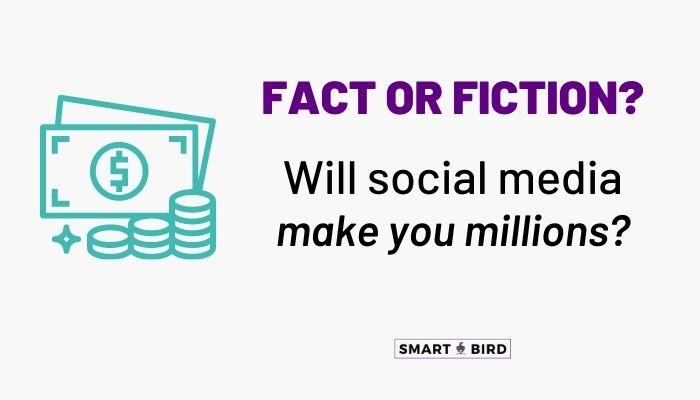
Social media is a perfect way to begin your customer buying journey. The sales funnel principles apply to social media just like any other sales process. Being active on social media means that people can discover your business, learn more about your brand, and get to know/like/trust you.
Lots of people dream about going viral on social media and making millions from it. That’s the exception, not the rule.
Bottom line: Social media is as strategic as any other marketing strategy. Treat it as such!
20) What are some of the benefits of social media marketing that I don’t know about?
In addition to building relationships, social media has other benefits that you may not know about. Here are a few.
Emotional Influence
For example, do you follow a celebrity on social media? When they post about a particular product do you think about buying it for yourself? This is called influence. Celebrities definitely have it. However, there are so many levels of influence that are utilized on social media.
For example, I have an Instagram and Facebook account called Grand Rapids Girl. We only have just over 7300 followers on Instagram and 554 on Facebook. But, we have enjoyed hundreds of dollars in free products and services in our area in exchange for a post!
How does this happen? We appeal to the emotion and interest of our fellow Grand Rapidians (aka the best city in Michigan! 😃). When we give something a shout-out, our followers take notice.

Pixels and Retargeting
Technically speaking, the beauty of social media marketing is that you are able to track your viewers every move. Facebook and Google both offer pixels, which are basically the same thing as a cookie. When you visit a website, there is a cookie placed on your computer. A company like Amazon, for example, uses the power of cookies in its advertising strategy.
Have you noticed that the products you search follow you around on the internet? Those are brands using behind-the-scenes retargeting to stay top of mind and remind you about them.
BUT, Apple’s new privacy rules are changing how retargeting works. Users will have to agree to some of these options that used to be fairly stealth. These changes will impact paid advertising. The ramifications are still playing out.
Reach
When you market on social media, you increase your business’ reach and visibility. One aspect of marketing is getting your brand in front of more people. And, social media delivers!
In my opinion, the benefits of social media marketing extend beyond selling into networking, fostering relationships, building a community, and so much more—which I find truly exciting!
Brand awareness and content amplification can help increase your website traffic and generate more leads.
Do You Have Additional Social Media Questions?
Wow! We covered a lot about social media marketing, didn’t we?
Social media marketing works. However, you need a plan, a budget, and expert knowledge to get the most out of it. Hopefully, these answers helped you understand that.
Did I answer your most burning questions? If you have any other questions, please let me know in the comments!
UPDATED APRIL 6, 2021 | PUBLISHED JULY 10, 2019

Lots of great stuff Anne and so much to cover.. I really hope folks will read it… as social media isn’t just about posting and getting sales. Business owners think they can post and they will come and that just doesn’t work. I am still on the fence about the number of times to post because if we post 1-3x, how many of those are actually being seen since FB is the queen of filtering it, so we are lucky to get anyone to see it. Anyways, great stuff Smart Bird! 😉
Thanks for the comprehensive FAQ, Anne. The point about images is one that needs to be taken seriously. I’ve issued quite a few DMCAs for images from my blog being used by newbie bloggers who ‘found’ it on Google not to mention blog posts copied for similar reasons and then a flurry of apologies when their website host providers took action. 🙂